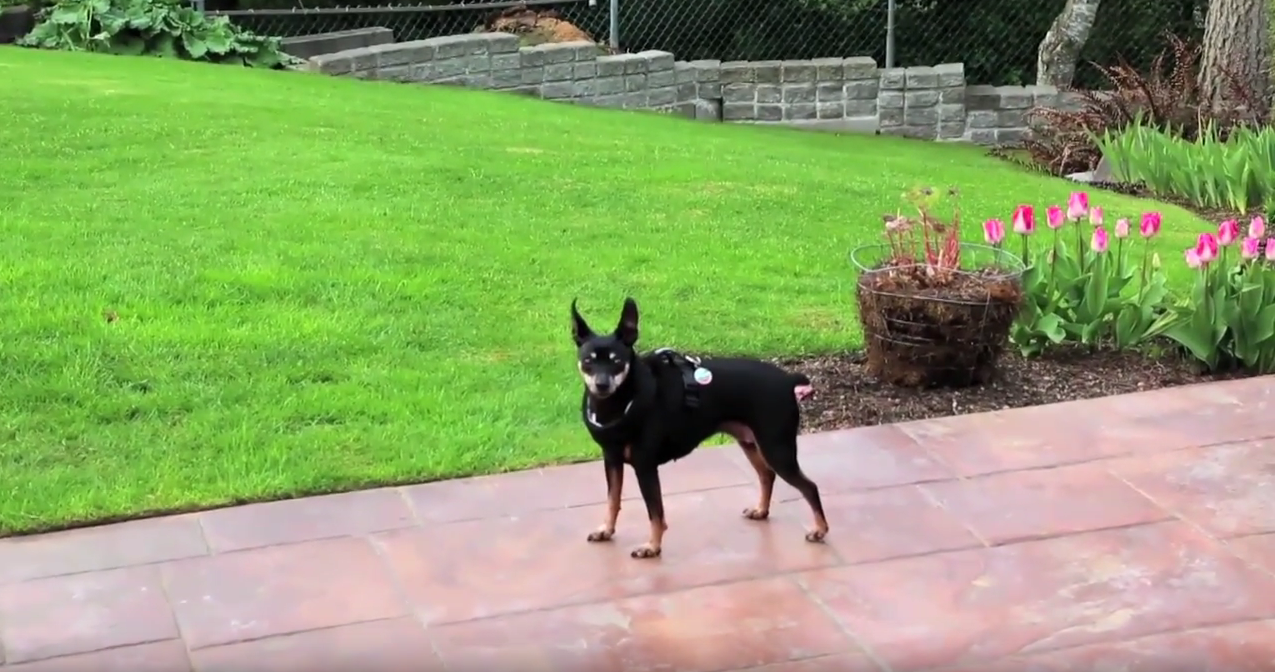When The Vet’s Dog Has Cancer – Part 2

By Dr. Laurence Braun, ER + Critical Care Specialist
[Editor’s Note: Earlier this year, Canada West Veterinary Specialists’ Dr. Laurence Braun experienced first-hand the range of emotions and considerations that our clients encounter as pet-owners of an animal in need of advanced care when her own dog was diagnosed with a fast-growing form of cancer.
In part one of this two-part blog series, Dr. Braun discussed the discovery, diagnosis and decision-making process that ultimately led her to have her dog sent to New York for an advanced technology treatment known as “cyberknife” radiation that is currently available at only four facilities in North America.
In this concluding post, Dr. Braun recounts her dog’s New York experience, current status, and future prognosis as well as Dr. Braun’s thoughts as a pet-owner on how to address a serious pet illness if it should arise in your own life.]
Mini Goes To New York
Mini’s appointment was for a Monday morning on the heels of a major snow-storm on the East Coast. It had taken two weeks to organize all the diagnostics, wait for the results and make the arrangements for her treatment. During this time, the tumor continued to grow.
While we had already done a CT at our hospital in Vancouver, a second CT had to be done in New York so that they could create “markers” (exact coordinates) to precisely guide the radiation and avoid most of the normal surroundings tissues. Dr. Charney called me at 6:00 a.m. on Tuesday and confirmed that the tumor was indeed larger, closer to the skin and that while Mini was still a good candidate for cyberknife treatment, she would be at higher risk for side effects (such as redness, burning or even wounds). With some trepidation, but trusting she was in good hands, I decided to go ahead. The cyberknife treatment was planned for the next day and she received 3 treatments on consecutive days. I spoke to Dr Ettinger the day of her first treatment and, afterwards, because the time difference made daily updates a bit problematic, the oncology technician sent me daily emails.

Once she was home, Mini recovered remarkably quickly. We started the chemotherapy a few days after her return. While some chemotherapy drugs can be given by mouth, the ones used for treating OSA are given intravenously. The medication we used, Carboplatin, is typically well tolerated by the patients. This means they don’t usually experience nausea, vomiting or diarrhea. However, the drug is excreted unchanged in the urine, and neither Mini nor our toddler are easily confined to certain areas of the house. I therefore decided to keep Mini at Canada West’s hospital facility on IV fluids for a couple of days after each treatment. The only side-effect from the radiation was hair loss over Mini’s shoulder.

Enjoying The Present, Considering The Future
While Mini is now very happy, my current dilemma is whether I will consider further chemotherapy or instead make the most of our happy, pain-free days, knowing that metastasis will be the most likely cause of her demise.
Mini tolerated the first chemo treatment well, but did not do as well with the second and then did quite poorly after the third treatment and continues to have moderately decreased kidney function. She drinks more and urinates more often, an easily remedied problem (more water bowls, more frequent pee breaks) but I am concerned that the renal toxicity occasionally reported with the chemo medication might cause kidney failure if further doses were given.
My Thoughts As A Pet Owner
Although few people will ever have their pet require cyberknife radiation, my general approach for most situations can be summarized as follows:
- Pet insurance decreases the stress of the financial burden.
- Early in the disease process, obtain opinions (consultations) from qualified specialists so that you and your pet have as many options as possible. Delaying may decrease the viable options.
- Consider your options over a couple of days if the situation allows. Make your decision once you have found a veterinarian whose professional guidance you trust. It is important that you have reviewed the relative risks and benefits of the recommended strategy and have a comfortable rapport and confidence in the treating specialist.
- The decision should be based on the scientific merits of the approach chosen but with considerationof the quality of life of the pet, the circumstances of the other family members (fur-bearing or not)and the day-to- day reality within your family schedule of commitment to the chosen treatment path. An educated choice considers the emotional and practical influences that are unique to each case.

